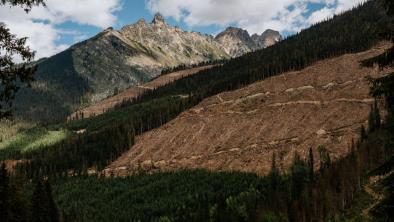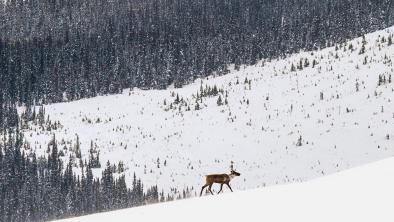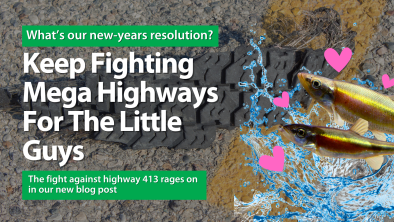Environmentalists sue to force Ottawa to protect species along Northern Gateway route
Globe & Mail

One of the most powerful foes of the proposed Northern Gateway pipeline through northern British Columbia is not a lawyer or a conservation group or any of the many First Nations who have lined up against the project.
It’s a very large, very, very old fish.
The Nechako white sturgeon is listed as an endangered species under the federal Species At Risk Act, a designation which is supposed to legally protect the sturgeon’s habitat so the species can recover.
The pipeline is planned to cross the Stewart and Endako rivers, where the highly imperilled species — there are estimated to be only 335 left — live.
But the recovery plan for the distinct sturgeon species has languished for seven years in draft form, never officially published and, therefore, never offering that protection. That recovery plan was due on Aug. 15, 2009.
“That [plan] creates an obligation on the government to ensure that the critical habitat of the white sturgeon is legally protected,” said Susan Pinkus, a biologist for EcoJustice. A coalition of conservation groups including EcoJustice have announced that they are suing the federal environment minister, Peter Kent, to force the government to enforce its own legislation on the proposed pipeline route that would carry bitumen from the Alberta oil sands to tankers on the B.C. coast..
The Western Canada Wilderness Committee, the David Suzuki Foundation, Greenpeace Canada, the Sierra Club and Wildsight say the minister is breaking the government’s own Species At Risk law.
They’re filing applications to the federal court for judicial review in the cases of the Pacific humpback whale, the Nechako white sturgeon, the marbled murrelet and the southern mountain caribou.
The groups say Mr. Kent’s ongoing refusal to publish the recovery plan for these species is against the law, and they want the court to compel the minister to do so.
“This is a population that [the Department of Fisheries and Oceans] has assessed as being able to tolerate no additional harm, for obvious reasons," Ms. Pinkus said of the sturgeons. “These guys are just barely hanging on.”
The lawsuit says under the federal Species At Risk Act, final recovery plans that would offer legal protections for the endangered species are long overdue.
“I can see how this would be controversial and perhaps uncomfortable, but I also think that this is why the Species at Risk Act exists,” Ms. Pinkus said.
The status of the sturgeon and Pacific humpback whales are mentioned repeatedly in countless documents obtained by The Canadian Press through Access to Information legislation or found among the thousands filed with the joint review panel conducting an environmental assessment of the project.
“Under SARA, all harm, harassment or killing of individuals from a species listed as endangered or threatened is prohibited,” said a Fisheries and Oceans memorandum on the project.
Once a species is listed, the department must develop a recovery strategy and action plan, which identifies and legally protects critical habitat from destruction, the 2011 document noted.
“The Minister of Fisheries and Oceans may only enter into an agreement or issue a permit authorizing a party to engage in activities affecting a listed wildlife species under SARA section 73 if pre-conditions are met. In particular, the harm to individuals associated with the activity cannot jeopardize the survival or recovery of the species.”
The document, a memorandum submitted to the regional director general, noted several species of concern along the proposed pipeline route.
Various populations of eulachon, a small smelt-like fish, are considered endangered or threatened by the Committee on the Status of Endangered Wildlife in Canada and are under consideration for listing under SARA. The same applies to quillback rockfish and yellowmouth rockfish, and northern abalone are listed as threatened under SARA.
The conservation groups pursuing court action over the pipeline proposal note that the marbled murrelet, a bird listed as threatened under SARA, and the southern mountain caribou, considered threatened, also live along the route.
Ms. Pinkus has particular concern for the humpback whale.
“If you superimpose the draft humpback whale critical habitat that DFO has identified, and the tanker route, you’ll be horrified. It goes straight through it,” she said.
Commercial whaling, overfishing of their prey, entanglement in fishing nets, noise and chemical pollution, as well as habitat destruction have led to their threatened status, says the SARA listing.
“A problem that has arisen in recent years is collisions of whales with ships. As ships get bigger and faster, it becomes harder for the whales to get out of the way. Many shipping lanes cross migration and feeding areas, making the risk of collision more likely,” says the SARA listing.
But like the white sturgeon, the deadline for a recovery plan has come and gone with no plan in sight. A draft plan has languished for more than two years.
The Fisheries documents submitted to the environmental assessment panel note that Northern Gateway proposed a trenchless crossing as the primary construction method on the Endako River, where the white sturgeon are present, and impact would be negligible.
“However, there is some risk that a trenchless crossing may not be feasible because of the site conditions,” the Fisheries documents say, adding that the contingency plan has an elevated risk of adverse impacts.
“It will be important for the proponent to ensure mitigation measures are sufficient and are implemented to avoid the risk of impacts to sturgeon.”
In the end, the department said the risk posed by the project to fish and fish habitat can be managed through mitigation and compensation measures.
But critics say that if Ottawa hadn’t broken its own laws around species at risk already, that would not be the case.
Earlier this month, Environment Minister Peter Kent told The Canadian Press that the Conservatives government is looking at an overhaul of the species at risk law enacted in 2002 by a Liberal government.
Mr. Kent said he wants to make the Species At Risk Act more efficient.
“There are improvements to be made,” Mr. Kent said. “Sooner rather than later we need to address changes to the Species at Risk Act to be more effective.”
The Conservatives made dramatic changes earlier this year to other environmental laws and the Fisheries Act — changes decried by conservation groups for putting resource development ahead of the environment.
Cory Williamson, a member of the Nechako White Sturgeon Recovery Initiative, said there are only about 335 white sturgeon left.
“The population is in continual decline,” he said.
The remaining fish are 40 to 70 years old. They spawn but the eggs and larvae don’t survive.
The prehistoric fish, which can grow up to six metres in length and weigh as much as 500 kilograms, has changed little since dinosaurs roamed the Earth but teeters on the brink of extirpation, he said.
“We have a recovery plan that’s been in draft format for a number of years now,” he said. “There are, I believe, legal prohibitions on harm to individual sturgeon, but because the recovery plan hasn’t been formally published yet, there is no legal protection for habitat.”
Brian Frenkel, the chairman of the community working group for the Nechako White Sturgeon recovery initiative, said there are several pipelines proposed for the area.
For five years, his group has been looking for $3- to $4-million to build and operate a sturgeon hatchery.
“The federal government has done a good job of creating a Species At Risk Act, and our group fought hard to put sturgeon on there,” Mr. Frenkel said.
Since then, Ottawa has “fallen flat on their face on that.”
“We’re so far from Ottawa,” Mr. Frenkel said. “Out of sight, out of mind.”


